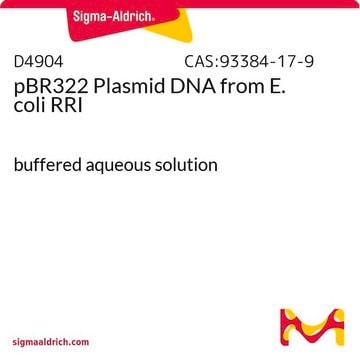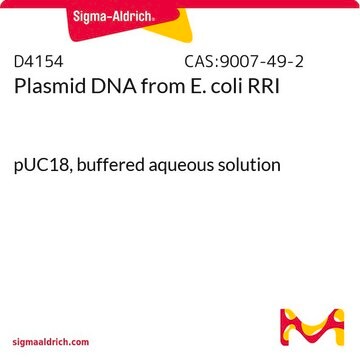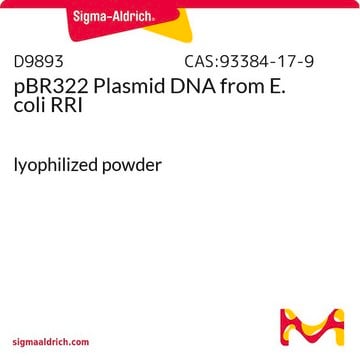D3404
Plasmid DNA from E. coli RRI
pUC19, buffered aqueous solution
Seleccione un Tamaño
$190.00
Seleccione un Tamaño
About This Item
$190.00
Productos recomendados
grado
Molecular Biology
for molecular biology
Formulario
buffered aqueous solution
Condiciones de envío
dry ice
temp. de almacenamiento
−20°C
cadena SMILES
[P](=O)(OC2C(OC(C2)N)CO[P](=O)(OC3C(OC(C3)N)CO)O)(OCC1OC(CC1O)N)O
InChI
1S/C15H31N3O13P2/c16-13-1-7(20)11(28-13)5-25-32(21,22)31-9-3-15(18)29-12(9)6-26-33(23,24)30-8-2-14(17)27-10(8)4-19/h7-15,19-20H,1-6,16-18H2,(H,21,22)(H,23,24)
Clave InChI
AWBASQCACWFTGD-UHFFFAOYSA-N
¿Está buscando productos similares? Visita Guía de comparación de productos
Descripción general
Aplicación
Acciones bioquímicas o fisiológicas
Foreign DNA inserted at the MCS abolishes the ability to catabolize lactose. Lactose-positive, ampicillin-resistant colonies (host strain containing plasmid) form blue colonies on plates containing ampicillin and X-Gal; lactose-negative, ampicillin-resistant colonies (host strain containing plasmid with foreign DNA inserted at the MCS) form white colonies on this medium. The orientations of the MCS regions in the pUC plasmids are analogous to those of the corresponding M13 phage.
Componentes
Principio
Producto relacionado
Código de clase de almacenamiento
10 - Combustible liquids
Clase de riesgo para el agua (WGK)
WGK 1
Punto de inflamabilidad (°F)
Not applicable
Punto de inflamabilidad (°C)
Not applicable
Elija entre una de las versiones más recientes:
¿Ya tiene este producto?
Encuentre la documentación para los productos que ha comprado recientemente en la Biblioteca de documentos.
disturbance suppression for nanostructure
imaging
Protocolos
Preparation for biodegradable nanoparticles and their use in transfection protocols .
Active Filters
Nuestro equipo de científicos tiene experiencia en todas las áreas de investigación: Ciencias de la vida, Ciencia de los materiales, Síntesis química, Cromatografía, Analítica y muchas otras.
Póngase en contacto con el Servicio técnico







